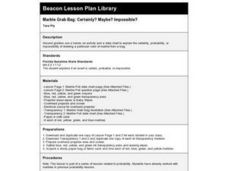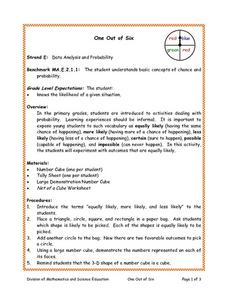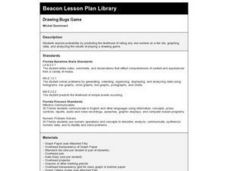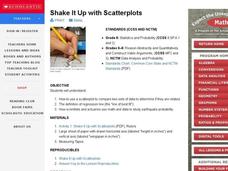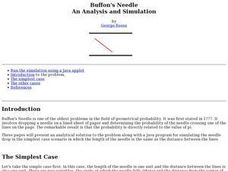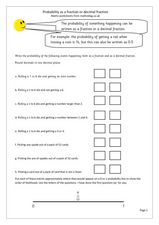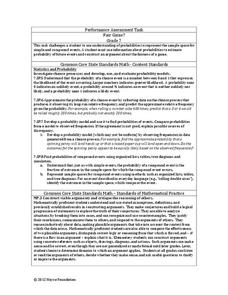Curated OER
Which Number Will Finish First?
Students conduct probability experiments. in this number lesson, students use spinners and conduct probability experiments. They collect and organize data on talley sheets.
Curated OER
Unit 21 Section 5: Estimating the Number of Successes
In this probability instructional activity, learners solve six short answer problems. Students enter their answers in the boxes provided and click on the answer button to check for correctness.
Curated OER
Marble Grab Bag: Certainly? Maybe? Impossible?
Second graders use a hands-on activity and a data chart to explain the certainty, probability, or impossibility of drawing a particular color of marble from a bag. This lesson plan comes with an excellent website, and many good...
Curated OER
An Introduction to Mathematica and the "Birthday Problem"
Twelfth graders determine the probability of two people in their class sharing the same birthday. In this determining the probability of two people in their class sharing the same birthday problem lesson, 12th graders use...
Curated OER
One Out of Six
Students investigate basic concepts of chance and probability. They make a number cube to predict which number might be rolled the most often out of 20 consecutive rolls and tally the results. Number cube template included.
Alabama Learning Exchange
Pennies, Pennies and More Pennies
Learners determine the number of pennies needed to fill a room. In this pennies lesson plan, students work in groups to determine the number of pennies needed to fill a room. They compute the probability of the head of a pin...
Curated OER
Drawing Bugs Game
Second graders explore probability by playing a drawing game with dice. After they roll a die, they draw a tree diagram to illustrate each of the possible outcomes.
Curated OER
Grab Bag
In this probability worksheet, 1st graders determine the probability of 4 scenarios with multiple choice answers. Students circle 2 of their choices and draw 2 of their choices.
Curated OER
Chapter 5 Review
In this statistics worksheet, students solve and complete 10 different types of problems. First, they determine the probability of various actions described. Then, students describe an appropriate model for the number described and...
Curated OER
Z-Scores related to Psychology
In this z-score worksheet, students identify the z-scores and percentiles corresponding to thirteen values. Students are also asked to find two probabilities. Worked solutions are provided after each question.
Curated OER
Combinations and Permutations
In this statistics worksheet, learners solve the probability of an event occurring using probability, permutation and combination. There are 17 questions with an answer key.
Curated OER
Snack Sack
First graders, after exploring agricultural products that can be considered snack foods, experience the concepts of ratio and probability. They analyze and record their class experience after dealing with the following snacks: peanut...
Curated OER
Shake It Up with Scatterplots
Learners identify how to use a scatterplot to compare two sets of data to determine if they are related. Then they identify and describe the definition of regression line (the "line of best fit"). Students also identify how scientists...
Curated OER
Heads or Tails?
In this probability learning exercise, 1st graders toss a penny in the air 5 times and fill in a chart on how many times it landed heads up and/or tails up. Students complete this activity three times.
Curated OER
The Color Spinner
In this probability worksheet, 4th graders look at a spinner and figure out the odds of the spinner hitting each space. They answer 9 short answer questions.
Curated OER
The Mathematical Implications of Lying
Students explore how statistics can be interpreted in different ways. In this probability instructional activity students complete a class lab activity then discuss their findings.
Curated OER
Lucky 7s
This helpful lesson explores the probability in tossing a coin and throwing dice. Specifically, it looks at the probability of getting numbers that are significant to the game of craps, assuming that once the math is understood, most...
Curated OER
What Are the Odds?
Middle schoolers identify and interpret various ways of expressing probability as a decimal, fraction, percent, or ratio. They solve problems based on probability as they apply to real world applications.
Curated OER
Buffon's Needle An Analysis and Simulation
If you dropped a needle on a lined sheet of paper what is the probability that the needle will cross one of the lines on the page? Surprise your class with how calculating this probability can approximate pi. This question is known...
Curated OER
Probability as a Fraction or Decimal Fraction
In this probability worksheet, 6th graders use fractions and decimals to state probability. Students respond to 9 questions stating the answer in each of the two forms.
Curated OER
Probability
In this probability worksheet, 5th graders complete three sets of probability questions that use sets of blue balls, a spinning wheel, and sets of golf balls and blue balls.
Curated OER
Probability and ICT Integration
Eighth graders use the internet and calculators to explore theoretical and experimental probability. Using a program on the calculator, 8th graders simulate a coin toss and a spinner to figure probability. They also perform classroom...
Curated OER
Probability
In this probability activity, students answer 2 simple questions related to given pictures. A website reference is included for additional resources.
Noyce Foundation
Fair Game?
The game should be fair at all costs. The mini-assessment revolves around the ability to use probabilities to determine whether a game is fair. Individuals determine compound events to calculate simple probabilities and make...
Other popular searches
- Experimental Probability
- Probability Games With Dice
- Probability Games
- Theoretical Probability
- Probability Sample Space
- Math Probability
- Compound Probability
- Probability and Statistics
- Genetics Probability
- Conditional Probability
- Probability Lesson Plans
- Simple Probability


